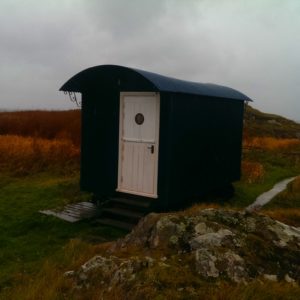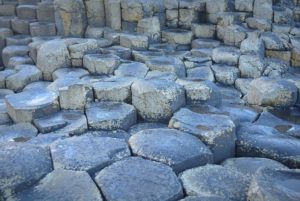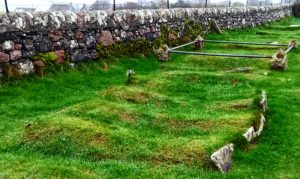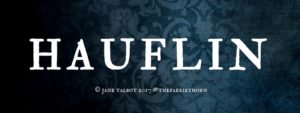With less than four months to go until opening night, and with rehearsals starting in March, the excitement about Big Telly Theatre Company’s stage production of The Faerie Thorn is building. The cast is in place. The script is well on its way. There’s music. There are songs. There’s a set and lighting design team. The tour schedule is ready to be confirmed.
And there’s something else: there’s a piece of new work being adapted for the production! The original idea was to adapt two stories from my collection of short stories (The Faerie Thorn and The Merrow of Murlough Bay). However, an interesting question arose about one of the key ideas in The Faerie Thorn (sorry – no spoilers here!) and Zoe Seaton, the Artistic Director, asked me to write a third story to explore that particular idea in more depth.
 Writing the new story has been an interesting experience for two reasons. Firstly, I wrote most of the story whilst I was on the Hebridean island of Iona. My main reason for being in the Hebrides was to do the research for my next book and so it was quite a challenge to switch between ‘being in’ the new story for Big Telly and being present to my surroundings and all the ingredients for my next book.
Writing the new story has been an interesting experience for two reasons. Firstly, I wrote most of the story whilst I was on the Hebridean island of Iona. My main reason for being in the Hebrides was to do the research for my next book and so it was quite a challenge to switch between ‘being in’ the new story for Big Telly and being present to my surroundings and all the ingredients for my next book.
I have a good understanding of my own writing process and I know that, for me, a connection with the settings for my stories is all-important. It seemed ironic that I was holed up in a tiny bothy a short boat-ride away from Staffa (an island that sits at one end of The Giant’s Causeway), writing a story set on Plaiskin Head (a place which overlooks the other end of The Giant’s Causeway).
 When I sat down to write every morning, I imagined myself rowing over to Staffa and then stepping onto the basalt causeway, using it as a magic short-cut home. At the end of my writing sessions, I imagined myself scrambling down to the shoreline at the Antrim end of the causeway and making the return trip to Staffa, rowing back to Iona in time for lunch.
When I sat down to write every morning, I imagined myself rowing over to Staffa and then stepping onto the basalt causeway, using it as a magic short-cut home. At the end of my writing sessions, I imagined myself scrambling down to the shoreline at the Antrim end of the causeway and making the return trip to Staffa, rowing back to Iona in time for lunch.
 I thought my cunning plan had worked – and, to the untrained eye, it has: the new story is drenched in northcoastness 😉 . However, what I hadn’t accounted for were the stowaways I took with me every time I made the ‘psychic journey’ across to Staffa and over to the Antrim coast. Stitched into every seam of the new story is something of Iona’s mysteriousness, something of the strange feeling that comes off the places I was drawn to: the faerie mound
I thought my cunning plan had worked – and, to the untrained eye, it has: the new story is drenched in northcoastness 😉 . However, what I hadn’t accounted for were the stowaways I took with me every time I made the ‘psychic journey’ across to Staffa and over to the Antrim coast. Stitched into every seam of the new story is something of Iona’s mysteriousness, something of the strange feeling that comes off the places I was drawn to: the faerie mound  (Sithean Mor), the White Strand of the Monks, the well on Dun-I, the inside of Saint Odhran’s chapel, the screaming face carved into one of the pillars in the abbey, and the graves that looked like whoever they were holding were not all-the-way-dead. And in the very fabric of the new story is a ghost from Reilig Odhrain (the graveyard surrounding Saint Odhran’s chapel).
(Sithean Mor), the White Strand of the Monks, the well on Dun-I, the inside of Saint Odhran’s chapel, the screaming face carved into one of the pillars in the abbey, and the graves that looked like whoever they were holding were not all-the-way-dead. And in the very fabric of the new story is a ghost from Reilig Odhrain (the graveyard surrounding Saint Odhran’s chapel).
Iona’s impact on this third piece reminded me how powerful ‘place’ is and how stories are held by places – and how a story that’s held by a powerful place has an instinct to survive and make itself heard (even if that means cuckooing its way into another story).
The second reason that writing the new story has been interesting is because something has changed as a result of working with the theatre company: what goes on in my head while I’m writing.
 Normally stories come to me in a voice. It’s a very distinctive voice, a voice from Here-There-And-Everywhere. The owner of the voice has a disregard for standard grammar and a penchant for making words up. I listen to the voice and if his (and it is a he) opening gambit grabs my attention, I start to transcribe his words. He’ll stay with me until the story is done. He might allow a character to sit next to me and offer suggestions now and again, but, in the main, he just talks and I listen. I don’t really see anything in my mind’s eye. Even if I write a description of something, it’s not something I see first and then describe. It’s something I hear.
Normally stories come to me in a voice. It’s a very distinctive voice, a voice from Here-There-And-Everywhere. The owner of the voice has a disregard for standard grammar and a penchant for making words up. I listen to the voice and if his (and it is a he) opening gambit grabs my attention, I start to transcribe his words. He’ll stay with me until the story is done. He might allow a character to sit next to me and offer suggestions now and again, but, in the main, he just talks and I listen. I don’t really see anything in my mind’s eye. Even if I write a description of something, it’s not something I see first and then describe. It’s something I hear.
When I started to write the new story, the voice was still there, but this time I saw everything being played out. This time the voice offered alternative scenarios for audition (this is in keeping with the devising process I mentioned in an earlier post) and the associated images came as rapidly as you’d see them generated in a devising session with actors. This time I noticed how the characters held the story in their bodies and not just in their words (this is in keeping with physical theatre) and how mesmerising it was to watch them move – or stay still. This time I noticed where the opportunity for play was to be found in the story because I could see it staring me in the face.
 Writing this new story, which I’ve called Hauflin, has been a rewarding experience. It’s shown me how searching for stories isn’t always necessary because, if you’re in the right place, stories will search for you – and find you in the end. It’s shown me how working with Big Telly has had an impact on my own creative process – and I think the impact has been a positive one. There’s something really visceral about Hauflin. I like that about it.
Writing this new story, which I’ve called Hauflin, has been a rewarding experience. It’s shown me how searching for stories isn’t always necessary because, if you’re in the right place, stories will search for you – and find you in the end. It’s shown me how working with Big Telly has had an impact on my own creative process – and I think the impact has been a positive one. There’s something really visceral about Hauflin. I like that about it.
Find out more about the devising process on The Guardian’s website.
Find out more about physical theatre on the BBC’s website.
Keep an eye on Big Telly’s website for details of the UK/Ireland tour schedule (to be issued shortly).